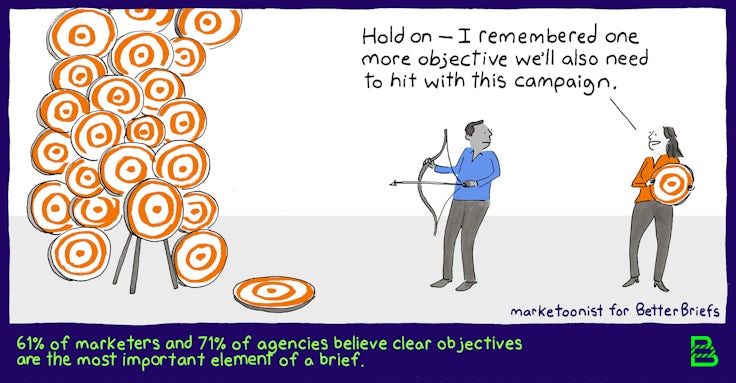Why too many objectives are ‘very bad’ for effectiveness
In the first of a new five-part series in partnership with BetterBriefs, Tom Fishburne, aka the Marketoonist, shares an exclusive cartoon while Peter Field and Wiemer Snijders analyse why lack of clarity and consistency on objectives when brief setting is hindering success.
Peter Field: If objectives aren’t consistent they belong in another brief
Setting the right campaign objectives is not easy, but we know it is extremely important.
There is always a tension between the desire to focus on a few objectives versus the fear of omitting any of the desired outcomes we seek. As is usually the case, the truth lies somewhere between the extremes. Effectiveness data is quite clear that too many objectives are very bad for effectiveness, but so too are no objectives or too few. What matters is a clear hierarchy of a manageable number of focused and related objectives.
In a recent survey of UK marketers, most thought that market share should be the primary objective at the top of the hierarchy. But in fact, the effectiveness data, as well as a number of academic studies, strongly argue against this. The trouble with putting share or sales at the top of the hierarchy is that it can encourage unprofitable tactics (such as excessive price promotion). The share target may well be achieved but too often at considerable cost to profitability. That is why academic studies have failed to find a reliable link between share growth and profit growth, something that is echoed in effectiveness data. And it is profit growth that ultimately matters to companies.
Too many objectives are very bad for effectiveness.
Peter Field
So, undoubtedly at the top of the hierarchy must be a profit target, followed by a subsidiary business target that will deliver this (perhaps a market share or pricing target or both); this might be underpinned by distribution or innovation objectives that will help deliver this and finally by communications objectives that will support it (perhaps to reposition or premiumise the brand, raise its salience or broaden its appeal and so on).
A campaign might get away with four or five related objectives (e.g. profit, share, distribution and salience), but there may be a few more to add. But no more than a few I would strongly suggest, and they should be consistent with the other objectives, not merely additional to them. If they are not consistent, then they belong in another brief for another campaign, another day.
Let’s remember Michael Porter’s wise advice that the essence of strategy is choosing what not to do.
Peter Field spent 15 years as a strategic planner in advertising and has been a marketing consultant for the past 25 years. He is the author of numerous books on marketing effectiveness, including The Long and the Short of It, which he wrote with Les Binet.
Wiemer Snijders: Keep it simple and be consistent
The BetterBriefs project provides some sobering statistics.
More than half the surveyed creative agencies felt the briefs they receive do not have clear objectives. We believe this is often because managers aren’t aligned on what truly drives the business so briefs end up as a portmanteau of convoluted ‘buck shot’ requirements, which at best obscure the job to be done and often miss it entirely.
It doesn’t have to be this way.
If we can agree that keeping it simple and doing so consistently is good, why is this so hard?
Growth strategy can be simplified to how to drive consumer/end-user choice to your brand and get paid appropriately for your product or service. More people paying the same or more for that product or service. At its simplest, the evidence is clear on the main goal. To quote Andrew Ehrenberg, the pioneer of evidence-based marketing science: “Of the thousand and one variables which might affect buyer behaviour, it is found that nine hundred and ninety-nine usually do not matter. Many aspects of buyer behaviour can be predicted simply from the penetration.”
A good brief should explicitly state its objective is to increase the brand’s customer base by driving one or more contributing factors.
Wiemer Snijders
To grow your brand, drive penetration – otherwise known as recruitment – over anything else. The much-coveted loyalty will come as a bonus. This sounds simple because it is, but it is the most effective strategy.
What does this mean for our brand-building plans and briefs to partners in practical terms? Ehrenberg liked ordinary words and sometimes talked about brands needing to be well-known, easy to find and buy, and being thought of as worth it. The first two parts of this recipe for growth are developed and characterised by the Ehrenberg-Bass Institute as building mental and physical availability.
To focus here on being well-known/mental availability, Ehrenberg recognised that advertising reminds far more than it will ever persuade. He also suggested we should see the task we call advertising as creative publicity.
Most marketing will be about maintaining your rightful place in people’s minds, on store shelves, contact lists and the web. Which is why a good brief should explicitly state its objective is to increase the brand’s customer base by driving one or more contributing factors.
These are:
- Reaching the right people (e.g. 80% of the market within the next quarter),
- Saying the right things (e.g. to have 25% of the market associating us with X), and
- Ensuring people will remember who did the talking (e.g. increasing the percentage of correct ad recall by 25%).
Wiemer Snijders is a partner at consulting firm The Commercial Works. He is also the curator of Eat Your Greens: Fact-Based Thinking to Improve Your Brand’s Health.
In partnership with BetterBriefs, Marketing Week will be exclusively publishing a series of cartoons from the Marketoonist over the next five weeks on some of the key issues plaguing marketing briefs, as laid bare by the BetterBriefs project when it launched in 2021. These will be shared alongside commentary from marketing heavyweights such as Marketing Week columnist Mark Ritson, System1’s Orlando Wood and former brand and agency leader Daryl Fielding who will dissect the issues and offer solutions to make briefing better for all parties.
In addition to objective setting, we will be exploring the misalignment between marketers and agencies and the need for a clear strategy, as well as creative evaluation and targeting.







